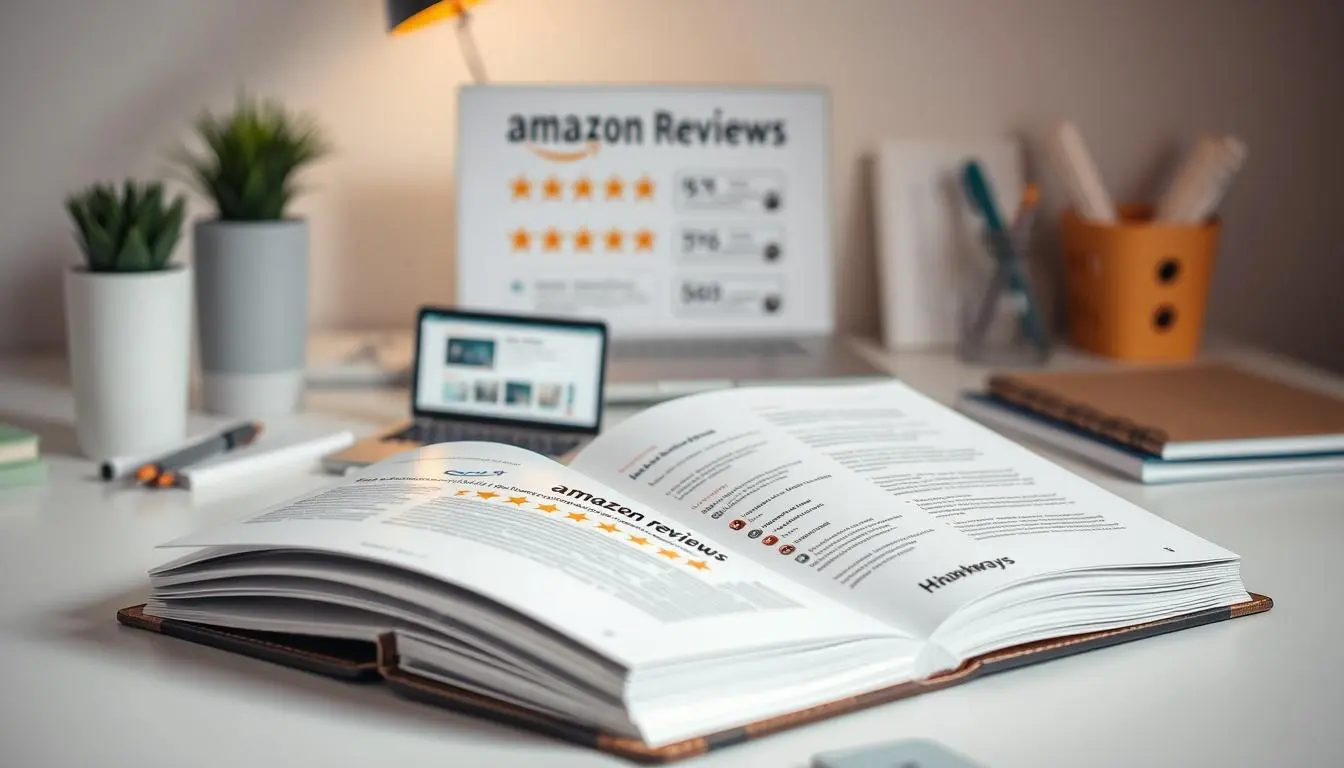Did you know 89% of Amazon buyers read reviews before buying? Yet, many sellers find it hard to get just one. In a place where trust is key, the right strategies can make shoppers loyal and boost your rankings. But how do you get Amazon reviews without breaking Amazon’s rules? This guide shows you how to safely increase your amazon review count.
Important Points To Remember
- Amazon product reviews impact visibility and conversion Amazon reviews influence product visibility and conversion rates.
- Focusing on customer satisfaction and systematic requests is why strategies are deemed ethical.
- Optimizing product pages and Amazon’s inbuilt options are basic steps of action.
- The Vine Program and Early Reviewer Program are some advanced tactics explored.
- Turning negative feedback into professional review management opportunities helps.
Why Sellers Need To Understand The Value Of Amazon Reviews
Trust and growing sales can be achieved because of amazon reviews. For sellers, reviews are not simply feedback. Managing business becomes crucial, and these reviews directly impact sales. I’ll outline the key points below.
The Review Impact On Product Visibility
A product with greater number of reviews will rank higher in Amazon’s algorithm. Items with 65% more reviews than others are 65% more likely to show up in Amazon’s search results. More positive feedback gets greater visibility among shoppers.
The Relationship Between Reviews and Conversion Rates
- Sales can increase by an average of 20 percent due to positive amazon reviews.
- Buyer behavior suggests that they read up to 10 reviews before making a buying decision; this means turning doubts into confidence.
Rating stars can help with lowering cart abandonment. However, a single negative review has the potential to frighten 33 percent of potential buyers.
Why Reviews Matter More Than Ever in 2023
“Reviews are the new currency of trust in e-commerce,”
industry research says. With 88% of shoppers reading reviews before buying, 2023 is more competitive than ever. Having lots of high-quality amazon reviews helps avoid algorithm penalties and keeps up with Amazon’s changing rules.
Sellers who don’t focus on reviews risk losing half of their sales. Creating a solid review strategy is not just helpful—it’s necessary to stay competitive in today’s market.
The Current Amazon Review Landscape
Amazon reviews are more important than ever for buyers. But, only 1-3% of customers leave feedback on their own. This makes it urgent for sellers to find new ways to get reviews, given changing consumer habits and Amazon’s rules.
After the pandemic, buyers started valuing quick service over reviews. But, it’s just as important to follow up with customers after they buy. In 2023, Amazon got stricter on fake reviews, penalizing sellers who offered contests or discounts to how to get reviews on amazon.
This change means sellers must use honest methods to get reviews. These include:
- Amazon Creator Connections partnerships for real promotion
- Brand Tailored Promotions to encourage repeat buyers who might review
- Proactive customer support to turn happy shoppers into reviewers
Electronics and beauty products get more reviews than cheap items, according to 2023 surveys. Sellers need to find a balance between following the rules and being creative. For example, they can include review request cards in packages.
For more tips, check out Amazon Brand Tailored Promotions. They help build loyal customers who might leave reviews. The key is to understand these trends to grow without breaking any rules.
Amazon’s Review Guidelines: What You Need to Know
Amazon’s review guidelines protect buyers and sellers from fraud. Ignoring these rules can lead to severe penalties. Knowing what’s not allowed helps keep your business in line.
- Offering discounts or gifts for amazon reviews
- Posting fake content
- Using family or friends to write biased feedback
- Listing removals and fines up to $10,000
- Temporary or permanent seller account suspension
- Loss of buyer trust and brand reputation
“Amazon reserves the right to remove any content violating its policies without notice.” – Amazon Seller Central
| Year | Policy Update | Impact |
|---|---|---|
| 2022 | AI tools detect suspicious patterns | Higher enforcement of amazon reviews |
| 2023 | Stricter penalties for incentivized reviews | Account suspensions increased by 40% (per seller reports) |
Being ethical is the first step to compliance. For more on balancing ads and reviews, explore ad performance metrics that align with review integrity. Always be transparent to avoid penalties and gain real customer trust.
Getting More Natural Reviews on Amazon Through Product Tweaks
Having great products get reviews on amazon. Make sure you put your best foot forward. First, ensure that your product passes every market examination and does not have any kinks. Amazon listing professionals claim that product quality is directly proportional to the number of positive reviews.
Concerns About Quality of the Product
- Do blind user tests with different age groups.
- Manage defect rates and mitigate problematic cycles.
- Enhance packaging material to withstand wear and tear during shipping as well as appealing during unboxing.
Packaging That Inspires Reviews
Make unboxing unique. Use vibrant colors and eco-friendly materials. This 2023 study showed that over three quarters of buyers mention packaging in their reviews.
“Customers who feel excited during unboxing are 2x more likely to leave a review.” – Retail Analytics Report
Including Review Request Inserts
| Compliant | Non-compliant |
|---|---|
| “We value your feedback! Leave a review at amazon.com” | “Leave a 5-star review for a $10 discount” |
Put small cards in packages with direct links. Say “Share your experience” instead of asking for a review. Try different places for the cards to see what works best.
How to take full advantage of the Request a Review button
The “Request a Review” button by Amazon is an excellent way to receive feedback from buyers. It sends out messages based on Amazon’s terms, which is a plus. For sellers, they can initiate this step on Seller Central by sending out emails containing a review link.
Choosing the right time is crucial. Research states that request messages sent out 3-7 days after a purchase are more likely to get responses. For example, utilizing this technique can yield a 7% response rate if done correctly. Other platforms such as Sellics or Amazon’s Review Solicitation Manager can effortlessly time these requests for thousands of orders ensuring Amazon’s 90-day rule is not violated.
- Make use of automation tools to effortlessly scale requests without having to do it manually
- To an extent, customize subject lines of the emails within set by Amazon’s template restrictions
- Identify peak engagement periods by testing send dates with campaigns.
Don’t overdo it. Amazon only allows one request per order, and too many can lead to account action. Make sure to offer great customer service to get real feedback. While the average response rate is around 7%, adding packaging inserts or follow-up emails can increase it without breaking any rules.
What is the Amazon Vine Program?

The Amazon Vine Program helps brands reach top reviewers. Here’s how it works:
Launched in 2008, the amazon vine program connects select reviewers with products before wide release. These “Vine Voices” receive free items to evaluate, providing honest feedback to benefit shoppers. This process builds trust and highlights quality products.
Origins and Purpose of the Vine Program
What is the Amazon Vine Program? It started as a way to amplify detailed reviews from Amazon’s most active reviewers. Sellers submit products, and Amazon selects items for distribution. This system ensures what is the amazon vine program remains a tool for unbiased insights, not paid promotions.
How Vine Reviews Differ from Standard Reviews
- Vine reviews display a Vine Voice badge, signaling credibility.
- They often include longer, more analytical feedback than typical reviews.
- These reviews appear immediately, giving new products instant visibility.
Benefits of Vine Reviews for Sellers
Joining the amazon vine program offers sellers:
- Higher search rankings due to early, detailed reviews.
- Exposure to millions of shoppers via highlighted feedback.
- Data on real-world product performance from diverse users.
While not guaranteed to boost sales instantly, Vine participation builds long-term credibility. Sellers must meet quality standards to qualify, ensuring only standout items gain this exposure.
How to Join the Amazon Vine Program for Sellers
To join the Amazon Vine Program, sellers must meet certain criteria. First, they need to be part of Amazon Brand Registry. Their products must also meet quality and inventory standards. Here’s how to join the vine program amazon seller:
- Verify eligibility: Check if your brand is in Brand Registry and if your products have enough stock in categories like electronics or home goods.
- Navigate to Seller Central: Find the Amazon Vine dashboard in the “Marketing” section of Seller Central.
- Select products: Pick ASINs that need early feedback, focusing on new launches or items with few reviews.
- Review fees: The program costs $200 per ASIN per country. Fees are charged 7 days after the first review, but no fee if no reviews in 90 days (learn more about fees here).
- Submit and monitor: Approve your enrollment, then watch review activity in Seller Central.
“Timing enrollment around product launches maximizes visibility, while careful product selection ensures ROI.”
For better results, target items with few reviews. Choose categories with lots of customer interest to increase visibility. Sellers in the program often see more reviews faster, helping them stand out in a crowded market.
Creating an Effective Follow-up Email Strategy
Follow-up emails are key to how to get reviews on amazon and keeping customer trust. They need to match user behavior to get responses without being too pushy.
Timing Your Outreach for Maximum Impact
Send emails 3-7 days after a purchase for quick items like beauty products. For longer-lasting goods like electronics, wait 14-30 days. Use data on when items are used to send emails at the right time.
Message Frameworks That Work
Use subject lines like “Share Your Thoughts on [Product]!” for better results. The email body should:
- Start with a thank you
- Include a direct link to leave a review
- Explain how feedback helps improve products
“73% of customers respond better to personalized emails mentioning specific product features.” – 2023 Email Marketing Benchmarks Report
Automation Tools to Streamline Requests
| Tool | Features | Pricing | Integration |
|---|---|---|---|
| Helium 10 | Review request workflows, A/B testing | $49/month | Amazon API, CRM sync |
| Perpetua | Automated email sequences, spam filtering | Custom | Zapier, Shopify |
| Sellics | Scheduled outreach, compliance checks | $99/month | Google Analytics |
Use these tools with PPC insights to match review generation with ad spending. Test subject lines with A/B splits to improve over time.
Building a Customer-Centric Approach to Generate More Reviews
At the heart of how to get reviews on amazon is a focus on customer experience. Amazon’s success, reaching $386 billion in 2020, shows the power of putting customers first. By making interactions memorable, businesses can turn happy customers into loyal advocates. 
- Personalize communication: Use buyer data to tailor post-purchase messages.
- Resolve issues fast: Address complaints within 24 hours to turn dissatisfaction into loyalty.
- Encourage feedback: Send follow-up emails with links to leave an amazon review.
- Reward loyalty: Offer discounts on future purchases for leaving reviews.
| Stage | Action |
|---|---|
| Pre-Purchase | Highlight product benefits in listings |
| Purchase | Ensure smooth checkout process |
| Post-Purchase | Automate review requests via email |
| Loyalty | Offer exclusive perks for repeat customers |
“Exceptional service transforms customers into brand ambassadors.”
Every interaction with your brand shapes how customers see you. Training teams to solve problems with empathy builds trust. For instance, Amazon Basics improved their products based on feedback, leading to more repeat purchases and reviews.
Consistent engagement over time creates a community where customers feel valued. This increases the chance they’ll leave an amazon review. This method focuses on building long-term relationships, not just quick fixes, to drive organic growth.
Advanced Tactics for Established Amazon Sellers
For sellers looking to grow, they need more than just the basics. The vine program amazon is a great start, but they also use other strategies to get more reviews and build trust.
Product Bundling Strategies
Bundle items that people want with extras like free guides or other products. This makes the deal seem better. For instance:
- Pair cleaning tools with kitchen gadgets
- Give free sample sizes with beauty products
- Add DIY assembly guides with furniture kits
Studies show that customers who get bundles are 40% more likely to write detailed reviews, as of 2023.
Unlocking Amazon’s Early Reviewer Program
The Early Reviewer Program is like the Amazon Vine. It lets select users try products early and give honest feedback. Sellers can:
- Target specific groups for feedback
- Get feedback before launching a product
- Get reviews before the product is fully available
Amazon Vine reviews can boost sales by up to 30%, making them a cornerstone of advanced strategies.
Maximizing Brand Registry Benefits
Brand Registry users get special features like A+ Content modules. These let them show off product details in a cool way. Benefits include:
- Customizable 3D product demos
- Premium brand story sections
- Exclusive badge visibility
Using the amazon vine review program with Brand Registry can really help. Sellers who do both see a 22% increase in review conversion rates.
Addressing Negative Reviews Professionally
Negative amazon reviews are a normal part of business. How sellers respond can make or break their reputation. A thoughtful reply shows customers their feedback matters. Here’s how to handle criticism well:
- Respond quickly but stay calm. Say sorry for the problem and offer fixes.
- Share your response publicly to show you’re accountable. Use private messages for deeper issues.
- Look for patterns in feedback to make your products better.
| Scenario | Action |
|---|---|
| Customer reports a defective item | Publicly thank them, ask for contact details to resolve privately |
| Fraudulent or abusive review detected | Report to Amazon using its policy violation form |
“Thank you for your feedback. We’re sorry to hear about the issue. Please email support@brand.com with your order details so we can replace the item and improve our quality checks.”
Keep public responses short and focused on solutions. Use negative amazon review interactions to show your commitment to customer care. For ongoing problems, update your listings or talk to the manufacturer. Turning criticism into action builds trust and loyalty.
Amazon’s seller support team can help with disputes that break the rules. By seeing feedback as a chance to grow, brands can turn negatives into proof of their dedication to customer happiness.
Conclusion: Creating a Sustainable Review Generation Strategy
A good review strategy mixes ethical actions with smart tools like the Amazon Vine Program. Sellers should focus on making high-quality products and keeping customers happy. This naturally leads to more feedback.
Using tools like optimized listings and post-purchase emails helps. Also, following Amazon’s rules is essential for long-term success. By using different ways to get reviews, businesses can avoid risks and gain trust.
Keep an eye on how reviews and sales are doing. The Amazon Vine Program gives valuable feedback. Personalized emails can also strengthen your bond with customers.
Always update your strategies to keep up with Amazon’s changes. This ensures you stay compliant and relevant. Making changes based on data helps find the most effective methods, like email campaigns or product bundles.
Being consistent and flexible is important. Always be open and solve customer problems quickly. This builds trust. Ethical practices also help avoid policy problems and encourage more growth.
Sellers who are creative but patient will do well. Amazon’s review world is always changing. Those who adapt and innovate will succeed.






